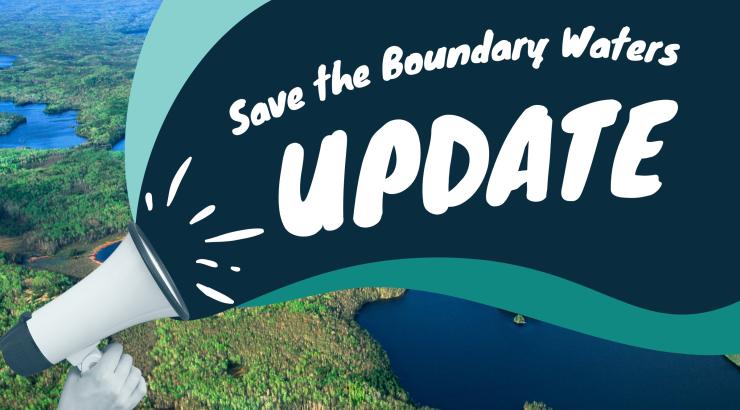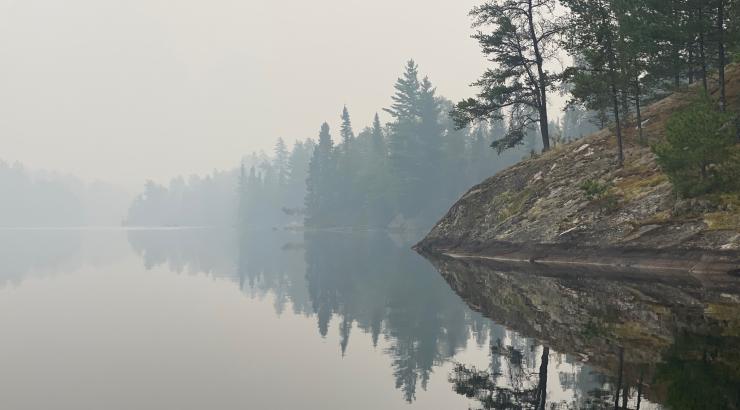Birch Lake is a popular recreational lake just outside of the federally designated Boundary Waters Canoe Area Wilderness in the Rainy River watershed near Ely and Babbitt. The water of Birch Lake flows into the Wilderness, and the area is ground zero for proposed sulfide-ore copper mining. Unfortunately, Birch Lake has been impaired by sulfate pollution from current and historic taconite mines for a long time, but this fact has largely been ignored. However, on November 14, the Minnesota Pollution Control Agency (MPCA) released its draft impaired waters list for 2024. The list includes Birch Lake and a portion of the Dunka River, both of which flow into the Wilderness, as impaired for sulfate.
Wild rice grows abundantly in Birch Lake, and the lake is officially classified as a wild rice lake, so it is covered by a state and federal water quality standard meant to protect wild rice from pollution. The MPCA’s 10 mg/L sulfate water quality standard is designed to protect this specific beneficial use — the use of the wild rice grain as a food source for humans and wildlife. Wild rice is culturally important to the Anishinaabe and is Minnesota’s state grain. It is also an important ecological indicator of water quality because sulfate pollution changes the ecology of lakes and streams and can be toxic to wild rice. In recognition of this, in 1973, Minnesota adopted a sulfate standard to protect wild rice based on studies showing that wild rice was found primarily in low-sulfate waters.
Mining interests want to put a sulfide-ore copper mine under this iconic lake. Sulfide-ore copper mining poses a significant danger to the delicate ecosystems of Birch Lake and the broader Boundary Waters watershed. Unlike iron-ore mining, sulfide-ore copper mining releases sulfuric acid, heavy metals, and other pollutants when sulfate is exposed to air and water. The potential for severe environmental degradation is high, as witnessed in other sulfide mining sites around the world. The risk of irreversible harm to water quality, wild rice, aquatic life, and surrounding habitats is too great.
Here’s what we are doing to help: Since 2019, Northeastern Minnesotans for Wilderness (NMW), founder and lead organization of Save the Boundary Waters, has monitored the waters of Birch Lake for sulfate through its water quality monitoring program. The data produced by this large-scale effort unequivocally demonstrates that the lake exceeds state standards for sulfate of 10 mg/L. The state agreed with our findings.
Since our water quality monitoring program began in 2019, we have gathered data at 93 different sites across Birch Lake, its tributaries, and downstream waters. This was no easy feat. Many of our monitoring locations are remote, making them logistically and physically difficult to access. It takes an immense amount of organization and coordination to execute this work to a high standard.

We actively monitor 42 of those sites on a monthly basis from May to September and about 15 of those sites year-round. In 2023 alone, we have been in the field collecting data on over 44 different sampling days. Not only do we test for sulfate concentrations, but we also test for other mining pollutants and take field measurements of water temperature, pH, dissolved oxygen, specific conductance, and water clarity.
We produced the most high-quality sulfate data for Birch Lake in the State of Minnesota. In fact, approximately 90% of the water quality data on Birch Lake in the MPCA’s database was collected by Save the Boundary Waters! We are a small but mighty team. As Dr. Patrick Brezonik, Ph.D., Professor Emeritus, University of Minnesota, said, "The most extensive and reliable sulfate concentration data available for Birch Lake were obtained by Save the Boundary Waters’ monitoring program."
Our high-quality science program is helping protect the Boundary Waters watershed. No agency, nonprofit, or other organization in the region is or has been doing water quality monitoring in the headwaters of the wilderness to the extent that we are. In developing this program, we pursued expert advice and training in establishing and implementing a scientifically rigorous and very high-quality monitoring program. Our team, led by Water Quality Monitoring Program Manager Lisa Pugh, began collecting a large quantity of data - including sulfate concentrations - in Birch Lake and its tributaries and later in waters downstream of Birch Lake. Our data is collected according to state and federal standard operating procedures for lake and stream monitoring, and our samples are analyzed by a state-certified laboratory. We follow the most stringent protocols for quality control and quality assurance. Our program and data have been peer-reviewed and are highly regarded by experts in the field.
Birch Lake is now on its way to being on the final impaired waters list, which means that the machinery of the Clean Water Act will begin to turn, requiring the cleanup of the mining pollution still being dumped into the lake, and it will be more difficult for dangerous mining projects to be permitted in the future.
However, though the MPCA added Birch Lake to its impaired waters list, the agency must be encouraged to consider it a top priority. A robust collection of multi-year water quality data is critical to permanently protecting the Boundary Waters watershed from the threat of toxic hardrock mining pollution. This is just the beginning of Save the Boundary Waters’ water quality program’s role in aiding in permanently protecting the Boundary Waters.
Make a donation today to help grow our water quality program.
Here’s what your gift to support our water quality science program helps fund:
- Transportation: many of our monitoring locations are remote and logistically and physically difficult to access. Executing this work to a high standard takes an immense amount of organization and coordination.
- Access to scientific equipment: lab fees for sample analysis are costly and add up. Sophisticated sampling equipment is expensive and requires maintenance and upgrading.
- Adding additional staff capacity: to ensure our data is validated and accepted by agencies, we need better equipment and increased capacity.
This is just the beginning of Save the Boundary Waters’ water quality program’s role in aiding permanent protection of the Boundary Waters. Help us expand this work.



